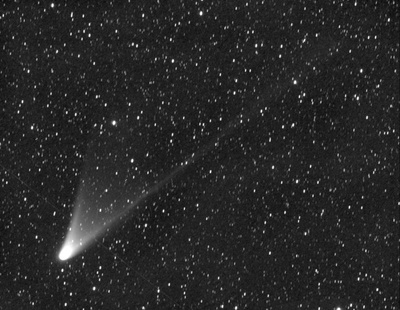Bright Comet in the Evening Sky
Discovered by and named after the Pan-STARRS telescope in Hawaii, the comet was first detected in June 2011, when it was an extremely faint object 1.2 billion km from the Sun. Looking at its path, astronomers soon realised that it could become very bright at its closest approach to the Sun (perihelion) on 10 March this year.
Like other comets of its type, PANSTARRS is thought to have originated in the Oort Cloud, a vast region containing millions of comets located more than two light years from the Sun. PANSTARRS travelled in towards the inner Solar system for millions of years, dormant for most of this time as a small nucleus made up of rock and ices.
When comets approach the Sun, these ices heat up, eventually turning to gases that jet out into space together with dusty material to form a head or coma around the cometary nucleus. Particles from the Sun (the so-called solar wind) blow the gases back in a straight tail, whilst sunlight exerts a pressure on the dust particles to create a curved tail. The two tails and coma make up the classic comet familiar in so many astronomical images but are not always easy to pick out with the eye.
Encouragingly, PANSTARRS has already been seen by observers in the southern hemisphere before perihelion, with reports that it is roughly as bright as the stars in the Plough and so is visible to the unaided eye. Later this week (by 8 March) the comet should start to be seen from the northern hemisphere, although to begin with it may only be visible through binoculars or a telescope.
By 12 and 13 March, PANSTARRS will be further from the Sun and should be easier to spot. To find it, skywatchers will need a clear sky, ideally be away from the lights of towns and cities and have a good western horizon. After sunset on those dates the comet will be low down in the west and appear as a misty patch not far from the crescent Moon. Using binoculars will make it easier to find and will certainly help identify the tails which should point up from the horizon.
As the days pass, the comet will move away from the Sun and fade and light from the Moon will interfere more. At the same time however, PANSTARRS will be higher up, will be visible later in the night and so be seen in a darker sky. After its brief period of visibility, the comet will travel back out towards the depths of space where it will be only be detected by large telescopes.
UK research astronomers are keen to encourage the public to look at PANSTARRS. Director of the Armagh Observatory Prof. Mark Bailey commented: "Bright comets are fairly rare and we usually don't know when the next one is on the way. Whether you're an experienced amateur astronomer or just have an interest, PANSTARRS is well worth a look."
Prof. Alan Fitzsimmons of Queen's University Belfast and one of the Pan-STARRS project leaders added: "Although we have discovered many comets with the telescope, so far this is the only one likely to be seen by eye. Comets can be quite beautiful and for that reason alone it's worth making the effort to see them."
